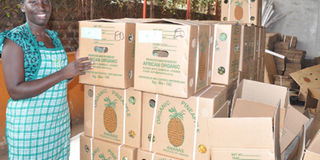Earn from cardboard boxes

Ms Lillian Anguparu displays packaged vegetables in cardboard boxes. Cardboard boxes are used for packing TVs, fridges, and bulky things such as soap, toothpastes and garments. Photo by Rachel Mabala
You can find waste in cardboard and turn it into something useful, for a profit. Recycling cardboard can be a good way of earning money while keeping the environment clean.
Since cardboard boxes are widely used in packaging consumer goods, pharmaceuticals plus fruits, vegetables and flowers for export, investing in making cardboard cartons makes economic sense.
Cardboard boxes are also used for packing TVs, fridges, and bulky things such as soap, toothpastes and garments.
Cardboard boxes (cartons) use regular cardboard that would otherwise be thrown away. They have the inherent advantages of being light in weight, easy to fabricate and store.
According to Uganda Investment Authority, recycling cardboard reduces litter on streets, while creating jobs for recyclers.
Capital
The market potential covers the entire packaging industry. The business idea aims at production of 62,400 boxes annually. The revenue potential is estimated at $90,355 (Shs325 million) per year with a sales margin of 28 per cent.
To start this business, you need total capital investment of about $9,614 (Shs34.6 million).
This mainly is accounts for procuring the recycling machine.
According to experts this project has a minimum plant capacity of 200 boxes per day on the basis of eight-hour single working daily shifts.
Mr Daniel Joloba, the chief executive officer Big Finance – a firm that does advisory and consultancy for Small and Medium Enterprises, says: “With increasing industrialization, the output can be increased with time depending on demand as operations gain experience.”
Production
Collection is the first step of recycling cardboard. Recyclers and businesses collect the waste cardboard at designated cardboard collection points.
Once the corrugated boxes arrive at the recycling facility, they are sorted according to the materials they are made of.
Then the boxes are shredded and mixed with water and chemicals to breakdown the paper fibres that turn it into a slurry substance.
The pulpy material is then taken through a comprehensive filtering process to get rid of all the foreign materials present as well as impurities such as strings, tape or glue.
The cleaned pulp is blended with new production materials after which, it is put to dry on a flat conveyor belt and heated cylindrical surfaces.
As the pulp dries, it is passed through an automated machine that presses out excess water and facilitates the formation of long rolls of solid sheet from the fibres called linerboards and mediums. The linerboards are glued together layer by layer to make a new piece of cardboard.
The process description involves deciding on the size and dimensions of your box,(drawing and cutting), gluing the pieces together, sanding the pieces to see if they are even, letting the pieces dry, joining them all and the product is ready for use.
Generally, boxes are prepared to customer specifications and the boxes/cartons can be prepared in different sizes, designs and colours.
Incentives
With this kind of investment, they can access skills development support from Private Sector Foundation Uganda to grow their business. With projects like Skills Development Facility, funds can be accessed by SME’s. Here, the SME identifies their need by applying to PSFU which then locates the institution and pays it to offer that skill.




